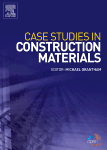
Case Studies in Construction Materials
Scope & Guideline
Elevating Industry Standards through Scholarly Insights
Introduction
Aims and Scopes
- Sustainable Construction Materials:
Research focusing on the development and application of sustainable materials, including recycled aggregates and waste by-products, to reduce environmental impacts in the construction industry. - Performance Evaluation of Construction Materials:
Studies aimed at assessing the mechanical, physical, and durability properties of construction materials under various conditions, including environmental impacts and load-bearing scenarios. - Innovative Material Technologies:
Exploration of new materials and technologies such as geopolymer concrete, fiber-reinforced composites, and other advanced materials that enhance the performance and sustainability of construction. - Numerical and Experimental Methods:
Utilization of both experimental and computational approaches to analyze the behavior of construction materials, including finite element analysis, machine learning, and advanced modeling techniques. - Durability and Long-Term Performance:
Investigations into the long-term performance and durability of construction materials, particularly under harsh environmental conditions such as freeze-thaw cycles, corrosion, and chemical attacks. - Application of AI and Machine Learning:
Incorporation of artificial intelligence and machine learning techniques to predict material performance, optimize mix designs, and enhance decision-making processes in construction.
Trending and Emerging
- Geopolymer and Alternative Binders:
There is a growing focus on geopolymer technology and alternative binders, driven by the need for sustainable construction practices and reduction of carbon emissions associated with traditional cement. - Recycling and Upcycling of Materials:
Research on recycling construction materials, such as concrete and asphalt, is on the rise, emphasizing the importance of circular economy principles in construction. - Smart and Self-Healing Materials:
The exploration of smart materials that can self-repair or adapt to environmental changes is gaining traction, reflecting advancements in material science and engineering. - Machine Learning Applications in Materials Science:
The application of machine learning and AI for predicting material behavior and optimizing construction processes is increasingly prevalent, indicating a shift towards data-driven research methodologies. - Durability and Climate Resilience:
There is an emphasis on the durability of materials under extreme environmental conditions, particularly in relation to climate change and sustainability, which is becoming a central theme in construction material research.
Declining or Waning
- Traditional Materials Research:
There has been a noticeable decrease in studies focused solely on traditional materials like plain concrete, as the field shifts towards innovative and sustainable alternatives. - Conventional Testing Methods:
The reliance on conventional testing methods for material evaluation is declining, with a growing preference for advanced numerical modeling and machine learning approaches. - Generalized Studies without Specific Innovations:
Papers that lack a focus on specific innovations or improvements in material technology are becoming less frequent, as the journal encourages more targeted and application-driven research. - Localized Case Studies:
There seems to be a reduction in localized case studies that do not have broader applicability, as the journal leans towards research with global relevance and sustainability implications.
Similar Journals

Functional Composites and Structures
Elevating Material Science through Collaborative Insights.Functional Composites and Structures is a prestigious academic journal published by IOP Publishing Ltd, dedicated to advancing the field of materials science with a focus on innovative composite materials and their structural applications. Established in 2019 and running through 2024, this journal uniquely bridges several disciplines, consistently ranking in the Q2 quartile across key categories including Ceramics and Composites, Electronic, Optical and Magnetic Materials, and Mechanics of Materials. With a commendable Scopus rank that places it within the top tiers of its field, the journal is instrumental for researchers, engineers, and scholars seeking to explore the latest developments in material properties, functionality, and applications. Although access options are not specified, the open-access nature of the journal promotes wider dissemination and engagement with cutting-edge research. As the demand for smarter, more efficient materials continues to grow, Functional Composites and Structures serves as a vital resource for fostering collaboration and driving innovation in material sciences.
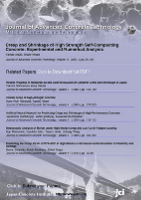
Journal of Advanced Concrete Technology
Transforming Construction Through Advanced Concrete SolutionsThe Journal of Advanced Concrete Technology, published by the JAPAN CONCRETE INST, is a leading academic journal dedicated to the specialized field of concrete technology, offering invaluable insights and research findings that push the boundaries of knowledge in construction materials and engineering. With an ISSN of 1346-8014 and an E-ISSN of 1347-3913, this journal has been an influential platform since its inception in 2003, converging its focus through to 2024. The journal holds a commendable position within the Q2 category in both Building and Construction and Materials Science for 2023 and ranks in the 63rd and 47th percentiles, respectively, reflecting its significant contribution to these disciplines. Accessible only through traditional subscription models, it is a critical resource for researchers, professionals, and students looking to explore contemporary advancements in concrete applications and innovations. Engaging with this journal not only enables a deeper understanding of materials science but also fosters collaboration and dialogue within the global engineering community, making it an essential read for anyone invested in the future of construction technology.
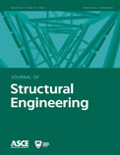
JOURNAL OF STRUCTURAL ENGINEERING
Transforming Ideas into Structural SolutionsThe JOURNAL OF STRUCTURAL ENGINEERING, published by the ASCE-AMERICAN SOCIETY OF CIVIL ENGINEERS, is a premier academic journal that focuses on the latest advancements in the field of structural engineering. With a rich history dating back to 1955, this journal has become a crucial platform for disseminating peer-reviewed research that addresses critical issues and innovative solutions in building and construction, civil and structural engineering, materials science, and mechanics. It proudly holds a Q1 quartile ranking across multiple categories in the 2023 Scopus rankings, indicating its influential presence in the academic community. The journal does not currently offer open access options, ensuring that the content is rigorously vetted for quality and relevance, thus appealing to researchers, industry professionals, and students seeking credible, impactful research. With contributions from leading experts, the JOURNAL OF STRUCTURAL ENGINEERING is essential reading for anyone interested in advancing their understanding and practice within this vital area of engineering.

Journal of Composites Science
Unleashing Potential Through Open Access ResearchThe Journal of Composites Science, published by MDPI, is a premier Open Access journal dedicated to advancing the field of composites and materials science. Launched in 2017, this innovative journal provides a platform for researchers, professionals, and students to share findings, methodologies, and insights related to composites, ceramics, and engineering applications. With an impressive Q2 ranking in both the Ceramics and Composites and Engineering (miscellaneous) categories for 2023, the journal is well-positioned within the academic community, ranking 48th out of 204 in miscellaneous engineering and 47th out of 127 in ceramics and composites according to Scopus. The journal's open-access model ensures that high-quality research is widely available to the scientific community, fostering collaboration and innovation. Situated in defensive Switzerland at ST ALBAN-ANLAGE 66, CH-4052 BASEL, the Journal of Composites Science is an essential resource for those seeking to stay at the forefront of the composites domain and drive progress in engineering practices.
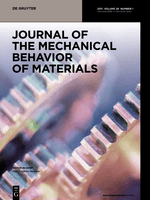
JOURNAL OF THE MECHANICAL BEHAVIOR OF MATERIALS
Connecting Theory and Application in Material BehaviorJOURNAL OF THE MECHANICAL BEHAVIOR OF MATERIALS, published by DE GRUYTER POLAND SP Z O O, is a prominent open-access journal in the field of materials science and mechanics, dedicated to facilitating the dissemination of high-quality research findings since 2019. With an ISSN of 0334-8938 and an E-ISSN of 2191-0243, this journal provides a platform for researchers, professionals, and students to explore the mechanical behaviors of various materials, crucial for advancing engineering and scientific applications. The journal's impact is evidenced by its impressive rankings, including Q2 status in both Materials Science (miscellaneous) and Mechanics of Materials as of 2023. With a Scopus rank placing it in the top-half of indexed journals, the JOURNAL OF THE MECHANICAL BEHAVIOR OF MATERIALS is a vital resource for anyone looking to stay at the forefront of material behavior research. Based in Germany, it serves the global academic community while catering to the evolving needs of industry practitioners through its comprehensive open-access model.

Magazine of Civil Engineering
Transforming Ideas into Structures: The Voice of Civil EngineeringMagazine of Civil Engineering, published by ST-PETERSBURG STATE POLYTECHNICAL UNIVERSITY, is a prominent open access journal dedicated to the field of civil and structural engineering. With an ISSN of 2712-8172 and E-ISSN 2071-0305, it serves as a vital platform for disseminating high-quality research, innovative methodologies, and current trends in building and construction. Since its inception in 2010, the journal has embraced open access, ensuring broad visibility and accessibility for its contributions to the academic community. The magazine holds a respectable position in the academic hierarchy, ranked in the Q3 quartile for both Building and Construction and Civil and Structural Engineering categories as of 2023. It is indexed in Scopus, amplifying its societal impact and reach with a rank of #114/223 in Building and Construction and #224/379 in Civil and Structural Engineering. Researchers, professionals, and students alike are encouraged to engage with the cutting-edge studies presented in the magazine, contributing to the advancement of knowledge and practice within the civil engineering domain.

Epitoanyag-Journal of Silicate Based and Composite Materials
Advancing Material Science through Silicate InnovationEpitoanyag-Journal of Silicate Based and Composite Materials is a premier international journal published by the Scientific Society Silicate Industry-SZTE, focusing on the development and application of silicate and composite materials. With its Open Access policy established in 2013, this journal provides a platform for researchers, professionals, and students to disseminate and access high-quality research without barriers. The journal aims to foster advancements in the field by covering a broad spectrum of topics, including material characterization, innovative applications, and sustainability initiatives related to silicate-based and composite materials. Its commitment to sharing valuable research makes it an essential resource for those looking to stay at the forefront of material science. Located in Budapest, Hungary, the journal not only serves a global audience but also contributes to the ongoing dialogue within the materials science community.
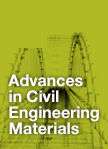
Advances in Civil Engineering Materials
Driving Innovation in Civil Engineering PracticesAdvances in Civil Engineering Materials, published by the American Society for Testing and Materials, is a leading journal in the field of civil engineering, specializing in the innovative applications and developments of materials used in construction and infrastructure. With an ISSN of 2379-1357 and an impressive lineup of contributions from renowned researchers, this journal serves as a pivotal platform for disseminating groundbreaking research from 2012 to 2024, currently enjoying a category quartile ranking of Q2 across multiple disciplines including Ceramics and Composites, Civil and Structural Engineering, and Materials Chemistry. Though it operates under a subscription model, the valuable insights and advancements presented in the journal have a significant impact on both academia and industry practices. Researchers, professionals, and students are invited to explore the evolving landscape of civil engineering materials, gaining critical knowledge to drive innovations and contribute to the sustainability and safety of architectural endeavors.

International Journal of GEOMATE
Connecting theory and practice in geotechnical and environmental engineering.The International Journal of GEOMATE, published by GEOMATE INT SOC based in Japan, is a pivotal resource for scholars and practitioners in the fields of Building and Construction, Environmental Engineering, Geotechnical Engineering, and Soil Science. Established in 2011 and continuing to set the standard in its focus areas, this journal serves as a platform for innovative research and practical applications, with contributions that significantly enhance the understanding and development of sustainable engineering practices. With its current classification in the Q3 quartile across multiple categories, it strives to disseminate critical knowledge and foster dialogue among a diverse audience, including researchers, industry professionals, and students. Though operating under a traditional subscription model, the journal's emphasis on rigorous peer review and high-quality publications ensures a substantial impact factor, further reinforcing its reputation in academia. Spanning from 2011 to 2024, the International Journal of GEOMATE invites contributions that advance the knowledge frontier and address contemporary challenges in engineering and environmental science.
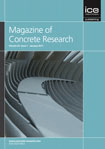
MAGAZINE OF CONCRETE RESEARCH
Pioneering Research in Concrete for a Resilient TomorrowThe Magazine of Concrete Research, published by Emerald Group Publishing Ltd, is a pivotal journal in the fields of Building and Construction, Civil and Structural Engineering, and Materials Science, boasting an impressive track record since its inception in 1949. As of 2023, it holds a Q2 category ranking across its related disciplines, indicating its strong influence and credible contributions to the field with Scopus ranks placing it favorably among its peers. With an emphasis on advancing knowledge surrounding concrete technology and construction practices, this journal serves as a key resource for researchers, industry professionals, and students alike. Though not Open Access, the Magazine of Concrete Research continues to cut through the complexities of concrete-related innovations, inspiring advancements in both academic research and practical applications. Engage with the latest findings and technological developments in concrete research, ensuring you stay at the forefront of this essential field.